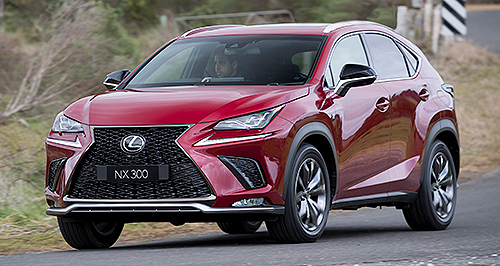New models - Lexus - NXLexus improves NX safety factorSafety first: While NX already featured autonomous emergency braking prior to this update, the system can now detect cyclists during the day and pedestrians at night. Improved AEB, lane-keep and steering assist highlight minor Lexus NX update18 Jun 2019 LEXUS Australia has given its NX mid-size SUV a safety boost, with the model’s suite of advanced driver-assist systems (ADAS) expanded for a relatively small price increase.
NX’s autonomous emergency braking (AEB) system now has extra functionality, able to detect cyclists during the day and pedestrians at night. The camera- and radar-based set-up could previously only identify pedestrians during the day.
AEB is also now active when parking, using NX’s front and rear sensors to detect obstacles when low-speed manoeuvres are being made, and automatically limiting throttle response and applying the brakes if the vehicle is about to make contact.
Lane-keep and steering assist, however, are new to NX, working in combination with its already standard all-speed adaptive cruise control with stop and go functionality to enable Level 2 autonomous driving, according to the Japanese brand.
Road sign recognition is also a fresh addition, displaying speed-limit sign information on NX’s multi-function display or its Sports Luxury grade’s windshield-projected head-up display.
These five features join NX’s expansive ADAS suite, which includes blind-spot monitoring, rear cross-traffic alert, high-beam assist, a reversing camera and tyre pressure monitoring, among others.
“These comprehensive updates further enhance the appeal of NX, making it one of the safest as well as sharpest-looking luxury SUVs on the road,” said Lexus Australia chief executive Scott Thompson.
As per usual, these upgrades come at a cost, with eight of NX’s 10 variants increasing their prices by $600, while the NX300’s F Sport AWD and Sports Luxury AWD derivatives have curiously jumped by $552 and $229 respectively.
As such, the NX line-up now starts from $55,400 before on-road costs for the NX300 Luxury FWD and tops out at $76,900 for the NX300h Sports Luxury AWD.
Based on the previous-generation Toyota RAV4’s platform, NX remains available with the choice between turbo-petrol (NX300) and petrol-electric hybrid (NX300h) power.
Offered in front- and all-wheel-drive forms, the NX300 is motivated by a 2.0-litre four-cylinder engine that produces 175kW of power and 350Nm of torque. It is mated to a six-speed torque-converter automatic transmission.
Alternatively, the NX300h combines a 2.5-litre naturally aspirated engine with one (front-wheel drive) or two (all-wheel drive) electric motors for a combined maximum power output of 147kW. It is paired to a continuously variable transmission (CVT).
Three grades are available, with the entry-level Luxury and mid-range F Sport available with both powertrains and both drivetrains, while the flagship Sports Luxury can be had in NX300 and NX300h guises but only with all-wheel drive.
Sales of NX have taken a significant hit this year, with 1301 examples sold to the end of May – a 21.4 per cent decrease over the 1655 deliveries made during the same period in 2018.
As a result, NX has fallen from fourth to fifth in the $60,000-plus mid-size-SUV segment, trailing the Mercedes-Benz GLC (2257 units), BMW X3 (2078), Audi Q5 (1546) and Volvo XC60 (1321).
*Excludes on-road costs  Read moreAll new models Alfa Romeo Alfa Romeo Abarth Abarth Alpine Alpine Alpina Alpina Audi Audi Aston Martin Aston Martin BMW BMW Bentley Bentley Chery Chery Brabham Brabham Chrysler Chrysler Chevrolet Chevrolet Cupra Cupra Citroen Citroen DS DS Dodge Dodge Fiat Fiat Ferrari Ferrari Foton Foton Ford Ford Great Wall Great Wall FPV FPV Haval Haval GWM GWM Honda Honda Holden Holden Hyundai Hyundai HSV HSV Isuzu Isuzu Infiniti Infiniti Jeep Jeep Jaguar Jaguar Lamborghini Lamborghini Kia Kia LDV LDV Land Rover Land Rover Lotus Lotus Lexus Lexus Maserati Maserati Mahindra Mahindra McLaren McLaren Mazda Mazda Mercedes-Benz Mercedes-Benz Mercedes-AMG Mercedes-AMG Mini Mini MG MG Nissan Nissan Mitsubishi Mitsubishi Pagani Pagani Opel Opel Porsche Porsche Peugeot Peugeot Ram Ram Proton Proton Rolls-Royce Rolls-Royce Renault Renault Saab Saab Rover Rover Smart Smart Skoda Skoda Subaru Subaru SsangYong SsangYong Tesla Tesla Suzuki Suzuki Toyota Toyota Volvo VolvoNX pricing
Motor industry news |
|















Facebook Twitter Instagram